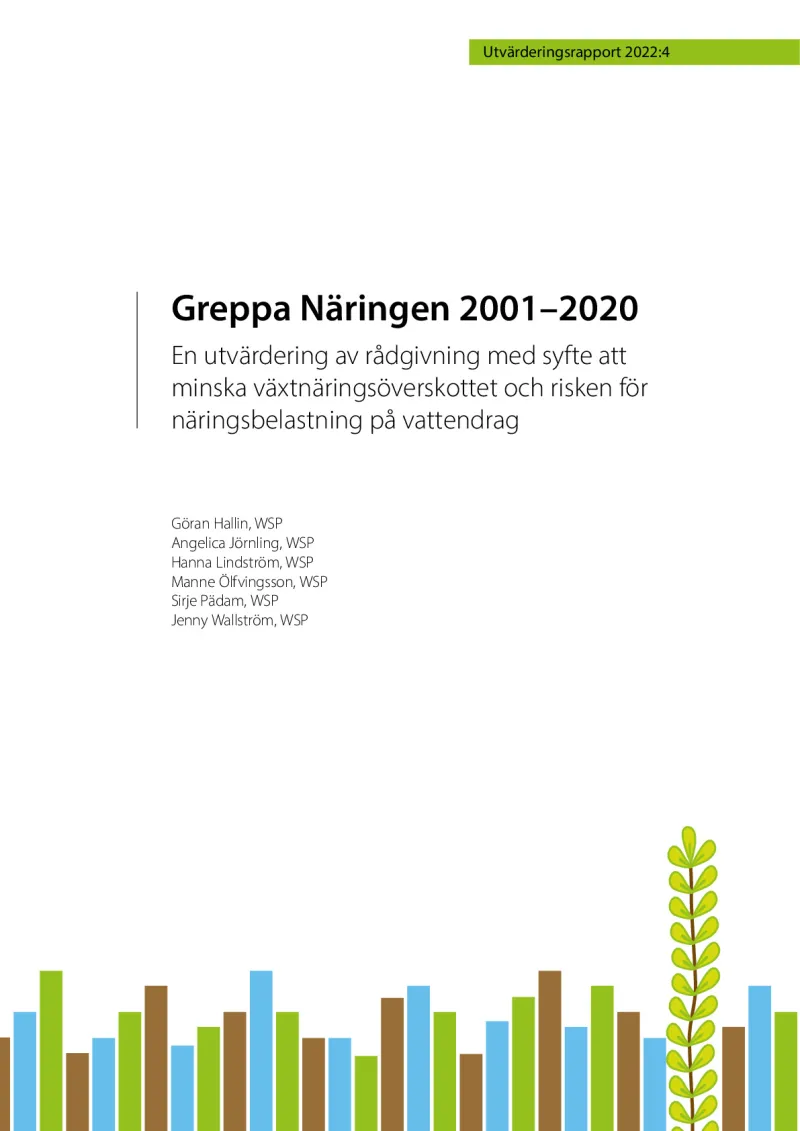Evaluating advice on reducing plant nutrient surplus and nutrient load in watercourses
The report analyses the effect of the advisory program 'Greppa Näringen' on plant nutrient balances in Sweden, focusing on the periods from 2001-2020 and 2014-2020.
- Sweden
- 2014-2022
- Environmental impacts


Greppa Näringen is an advisory program that started in 2001 in Skåne, Blekinge and Halland and is now offered free of charge to farmers throughout Sweden. Its goal is to reduce emissions from climate gases, reduce eutrophication and increase the safe use of plant protection products. Greppa Näringen is part of the Swedish Rural Development Programme (RDP) and is implemented in collaboration between the Swedish Board of Agriculture, the Swedish Farmers’ Association (LRF), the county administrative boards and various advisory companies in the agricultural sector. This report is part of the evaluation of the 2014-2020 RDP.
The evaluation secretariat of the Swedish Board of Agriculture is responsible for the evaluation that was carried out by independent consultants, WSP.
The evaluation was carried out to assess whether advice performed by Greppa Näringen affected plant nutrient balances during the 2001-2020 and 2014-2020 programming periods.
The evaluation answered the following questions: 1) To what extent has Greppa Näringen influenced plant nutrient balances in 2001-2020 and specifically in 2014-2020? 2) What are the most common advisory modules aimed at reducing the surplus in the nutrient balance? 3) Within the most common modules, what are the most commonly proposed measures aimed at reducing the surplus in the nutrient balance? 4) To what extent have farmers implemented the most commonly proposed measures? 5) What are the expected effects of the measures implemented on plant-nutrient surpluses?
The evaluation was mainly carried out as a quantitative analysis. A statistical method (multiple regression) was used to evaluate plant nutrient balances systematically and scientifically on farms. The analysis also includes control variables for factors other than the number of counselling sessions that may affect plant nutrient balance surplus. The quantitative analysis was complemented by a qualitative analysis carried out through interviews with plant nutrition experts, both within and outside advisory activities.
The analysis was based on Greppa Näringen databases. The documentation consists of panel data on the farms participating in the advisory programme from 2001-2020. The database includes information on established plant nutrient balances of the farm, the number and type of advisory modules a farm has taken note of, dates of these advisory activities, and the extent to which a farm has implemented various measures within the framework of Greppa Näringen.
In addition, the database contains information on farms’ production, municipality and county affiliation, the number of livestock units by species, the proportion of the farm’s crop production and organic livestock farming, the total arable area of the farm, the distribution of the arable area between different soils and mullars, and the distribution of the arable area between different crops. In total, over 20 000 plant nutrient balances have been established on approximately 10 000 farms during 2001-2020.
Some limitations were reported about the lack of a control group and, for some accounting groups, the lack of a sufficient number of observations (farms).
The report concluded that no link exists between providing more advice and changing plant nutrient balance. With a few exceptions, it was not possible to draw statistically significant conclusions on the effect of the advice on plant nutrient balances. At the same time, the evaluation showed that farms in all production areas have reduced their plant nutrient surplus balance over time, and the same applies to most of Sweden’s counties.
In addition, common measures to reduce plant nutrient balance surplus have been implemented. Farmers have, to a large or some extent, implemented several measures proposed during advice that reduce the surplus in plant nutrient balance (e.g. consider the average harvest level in fertilisation), which can be expected to have a positive effect.
Author(s)
Göran Hallin, Angelica Jörnling, Hanna Lindström, Manne Ölfvingsson, Sirje Pädam, Jenny Wallström. WSP